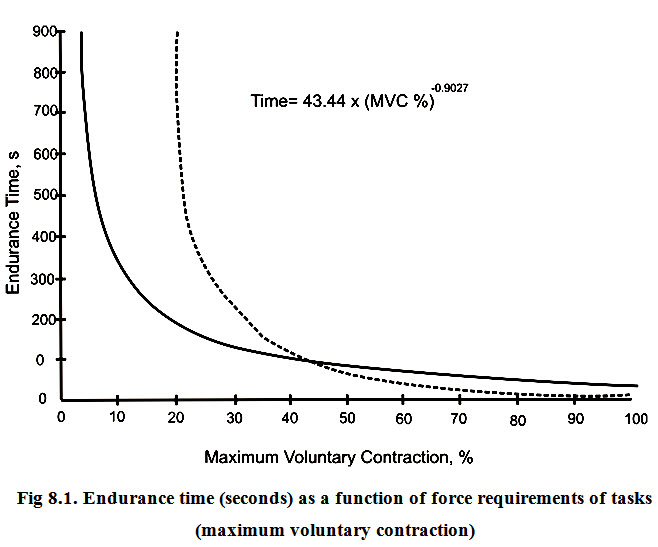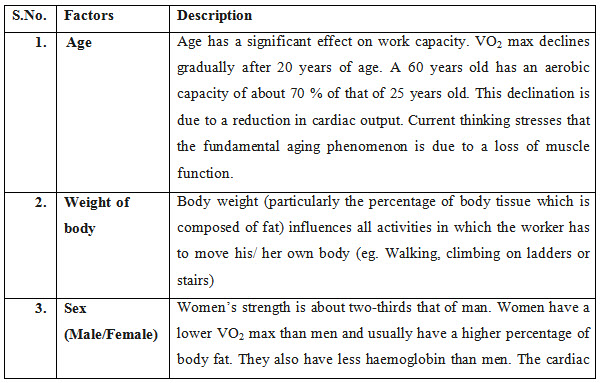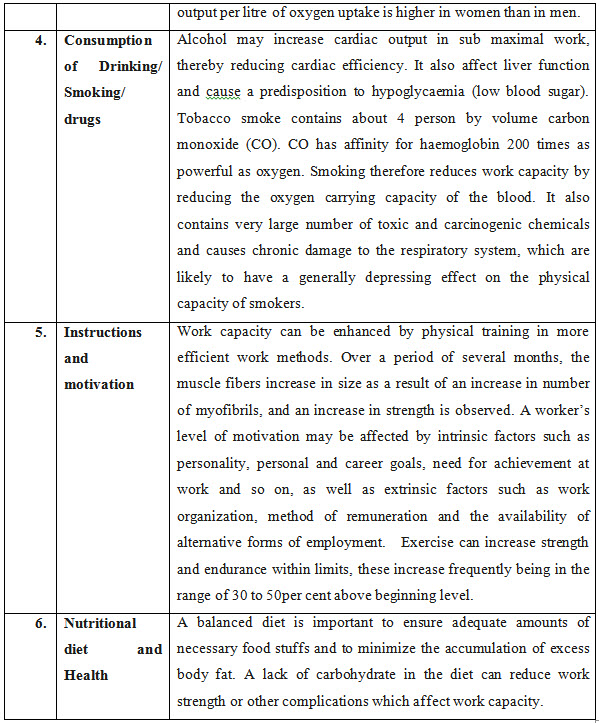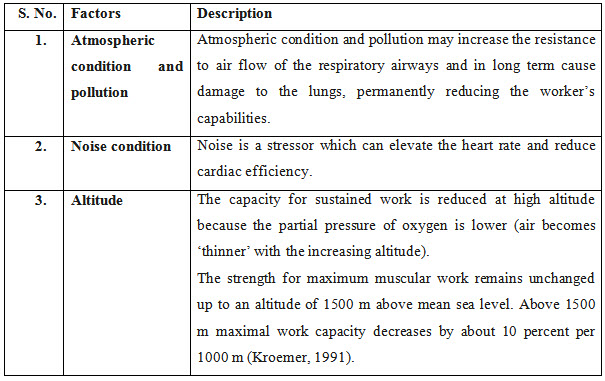Site pages
Current course
Participants
General
Module 1. Introduction to human engineering
Module 2. Human performance and responses
Module 3. Working environment and work space design
Module 4. Rehabilitation scheme and DMR Act
Topic 5
Topic 6
Topic 7
Topic 8
Topic 9
Topic 10
Lesson 8. STRENGTH AND ENDURANCE, SPEED AND ACCURACY, HUMAN CONTROL OF SYSTEM
8.1 Strength and endurance
Strength is the maximum force, that muscle can exert isometrically in a single voluntary effort, that is the muscular capacity to exert force under static condition. Human strength is a measure of an individual’s physical capabilities, especially ones that permit a person to exert force or sustain external loading without inflicting personal injury (Mital and Das, 1987). Determination of human strength capabilities is necessary to design and develop engineering guidelines. Upper body strength is frequently required for performing manual tasks in domestic, agricultural and industrial environments. Hence it is very important to know the maximum strength capabilities of humans to design the different equipments and machines to match the capabilities of the worker and to working with safety without injury. Since most human activities consists of dynamic efforts rather than static efforts. Knowledge of worker strength is very important in designing tools, equipments and machines to improve the human work interface.
Muscle/ arm strength and endurance are two important aspects of neuromuscular performance.
8.1.1. Muscular/ Arm Strength –The ability of a muscle to exert maximum force against resistance; 1 RM (Repetition Maximum). Muscular strength is the ability to generate force with a muscle or group of muscles; whereas, muscular endurance is the ability to perform repeated contractions with a muscle or group of muscles. Strength is the maximal force muscle can exert isometrically in a single voluntary effort, that is, the muscular capacity to exert force under static conditions and is usually measured by the use of an external device such as hand dynamometer or a device for measuring the force exerted against some object.
8.1.2. Muscular Endurance – The ability of a muscle to exert sub-maximal force repeatedly over a period of time. The difference between muscular strength and muscular endurance can be better understood by reviewing how each is assessed. Muscular strength is assessed by determining the maximal amount of force that an individual can apply against resistance-one time (1 RM), such as with a bench press or possibly a push up. Muscular endurance is assessed by determining how many times that an individual can apply sub-maximal force upon a weight (or body weight), such as bench-pressing x pounds twenty five times, or the total number of sit-ups, or push-ups one can perform.
Endurance time is defined as the maximum amount of time a subject could continuously hold a given weight in a specified posture. Beyond this time the subject could no longer hold the weight due to fatigue or pain in the shoulder girdle

8.2 Limit of Endurance
It is the ability to keep up some general body activity over a period of time. The endurance of a operator would be a function of the total energy cost of the activity and the energy expenditure the operator can reasonably maintain over time. If energy costs exceeds from the reasonable limits, rests should be provided to keep total energy requirements within bounds. Continuous stress on certain muscles in the body as a result of a prolonged posture or repetitive movement leads to localized muscle fatigue, a state of muscle discomfort and reduced muscle performance. As a result, the posture or movement cannot be maintained continuously. Garg et al. (1999) determined the endurance times for a continuous hold as a function of per cent maximum voluntary contraction (MVC) and shoulder flexion angle. Endurance time was defined as the maximum amount of time a subject could continuously hold a given weight in a specified posture. Beyond this time the subject could no longer hold the weight due to fatigue or pain in the shoulder girdle. The endurance decreased non linearly with the increase in % MVC. Fig. 8.1 depicts the general pattern of endurance time as function of force requirements of the tasks. The greater the muscular effort (exerted force as a percentage of the maximum force), the shorter the time it can be maintained. Most people can maintain a maximum muscular effort for no more than a few seconds and a 50 per cent muscular effort for no more than approximately two minutes as this causes muscular exhaustion (Jan Dul, 1993).
8.3 Factors affecting muscular/ arm strength: The ability to exert extremely great forces depends on muscle mass and the utilization of energy stores in the muscle itself. Many factors can influence the human strength to carry out physical work. The factors can be broadly classified in two groups, (i) Personal and (ii) Environmental.
8.3.1 Personal factors: Personal factors may be age, body weight, gender/sex (male/female), consumption of drinking/ smoking/drug consumption, training, instruction, motivation, nutritional status and general health etc, which has been described in Table. 8.1
Table.8.1 Personal factors affecting muscular/ arm strength


8.3.2.Environmental Factors: Many environmental factors can degrade strength and work capcity of the worker, viz. atmospheric pollution, air quality, ventilation, altitude, noise, vibration, extreme heat or cold etc as described in Table. 8.2.
Table.8.2 Environmental factors affecting muscular/ arm strength

8.4. Speed and accuracy
One of the major determinants of inspection accuracy is speed of working. Speed generally is the primary requirement in executing movements that are otherwise not difficult or demanding, such as in applying the brake pedal of an automobile or reaching for parts to be assembled.
In turn accuracy is the primary requirement in executing such movements as those in tracking (in which continuous control is required), in certain positioning actions that require precision and control, and in certain manipulative activities. However, in some circumstances both speed and accuracy may be required. Speed and accuracy are expected to be inversely related. We have experienced speed–accuracy trade-offs many times as you have completed various tasks. For example, we know from experience that the faster we move our computer mouse, the more likely we are to miss the icon you are moving to click. Just as speed is often measured by its reciprocal. time, similarly accuracy is measured by its complement, errors.
An error-free performance, in a discrete task, is an accurate performance. Drury (1991) follows many others in concentrating on error probability, or error rate, defined as:
![]()
For repetitive tasks, error rate is typically defined per cycle, so that we have sewing errors per 100 pair of jeans, near misses per flight.
8.4.1 Response time
The time required to make certain responses can be influenced by a number of variables, such as the nature of the stimulus, the number of choices, the degree of expectancy, and the device used. In some instances the total time required can be of substantial consequence. For example, the response time of the pilot of a supersonic aircraft on a collision course can be as long as 1.7 s, this being the simple addition of 0.3 s for visual acquisition of the other aircraft, 0.6 s for recognition of the impending danger, 0.5 s for selection of a course of action, and 0.3 s for initiation of the desired control response. Add the response time of the aircraft itself and it would be futile to take any action if the planes were closer than about 4 miles. The reaction time is used to describe the means by which the signals or data is conveyed to the central mechanism. It is the time taken to respond the data or signals.
8.5. Human control of system
There are many functions whose identifications needs intelligences, can be performed by human in a better way unless it is highly complex. Some of the functions performed by human are:
i) Human being can sensing minimum stimulate from a wide range of sources and complete the signals to bring a complete event or task.
ii) Human can amplify the signals or take some action in reference to what he has perceived.
iii) Human can perceive a signal in three dimensions and can interpolate and extrapolate. Human can do prediction also on the basis of signal data or sign boards, signal of speed limit, speed breaker, railway crossing ahead etc. would automatically cause the operator/ driver to slow down the vehicle for fairly accurate judgement.
8.5.1 Muscular control movement
Generally physical work is performed by the activation or control of musculoskeletal system. Muscle constitutes about 45% of the total body weight and plays the most important role in working efficiency. The most important characteristics of muscle tissue is its ability to contract with a certain force. The force of muscular contraction depends upon the number of activity contracting muscle fibre and the speed depends upon the amount of force exerted with in a fixed time which is regulated by the number of fibres activity contracting that time.
8.5.2 Nervous control Movement
The brain of human body is connected with each muscle and therefore the nervous system is to control the body organs activity. During stimulation nerves cells send out impulses along the nerves fibres to the concerned organs.
Each muscle is connected to the brain by two types of nerves i.e sensory and motor nerves.
Sensory nerves: Sensory nerves begin in the muscle spindle, which are stimulated by the change in tension and length of muscle and send impulses along with the sensory nerves in the spinal chord. These sensory impulses are finally perceived in the brain as sensations of hearing, vision, taste, position, force and tension. For the delicate of muscular movement, they provide information about the state of muscular system.
On the strength of the visual information, brain controls the further sequence of movements. When the object is grasped, new information reaches the brain alters the grip pressure, this process continues till the work is accomplished.
Motor: This motor nerves actually controls the actions of muscle. The microvolt action difference is transmitted to the muscle fibre through motor in the form of pulse and which intern controls the force, speed and movement of muscle. The nerve impuls originate in spinal chord whereas a sequence of reflex in spinal chord, whereas a sequence of reflex activities, action potentials are submitted in the motor nerves.
References:
Sai Chaitanya Reddy Bogolu .Effect of repetitions on static and dynamic strength.. Submitted to the Graduate Faculty of the Louisiana State University and Agricultural and Mechanical College. May 2006
Mital A., Das B. 1987, Human Strengths and occupational safety. Clinical Biomechanics, 2, 97-106.
G Arg, A., Hegmann, K.T. 1999, Endurance time as a function of the percentage of maximum voluntary contraction and upper extremity posture in healthy females.
Proceedings of the IEA 2000/HFES 2000 Congress, 437-440.
Kroemer, Khe. 1991. Working strenuously in heat, cold, polluted air and at altitude. Applied Ergonomics, 22:385-389.
Jan Dul and Bernard Weerdmeester. 1993.Ergonomics for Beginners A quick reference guide. Taylor & Francis 11 New Fetter Lane, London EC4P 4EE. ISBN 0-203-21209-6
Drury, C. G. 1994. The speed-accuracy trade-off in industry. Ergonomics 37: 4,747-763
Dalela, S. and Saurabh. 1999. Text book of workstudy and ergonomics. Standard Publisher Distributors.